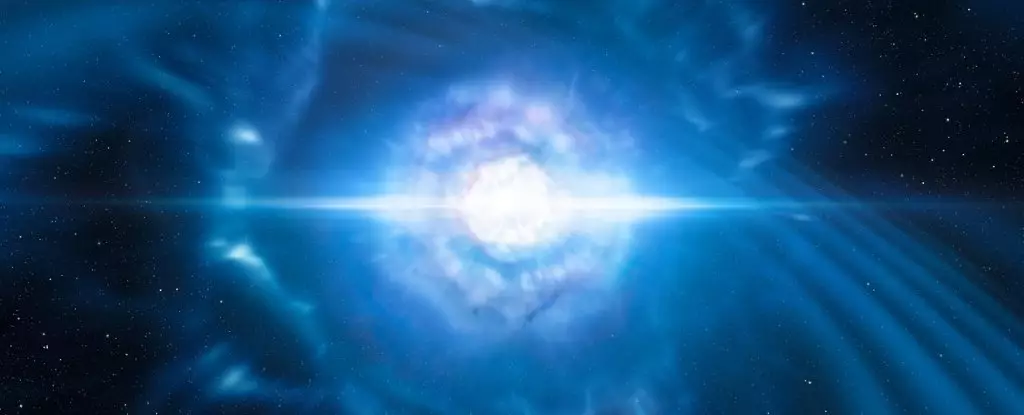In August 2017, astronomers and astrophysicists around the globe were captivated by a significant cosmic phenomenon—the collision of two neutron stars. This event, observed for the first time, provided a once-in-a-lifetime opportunity to study the complex interaction between these compact celestial bodies. The gravitational waves emitted during their spiral merger created ripples across the universe, signaling the formation of a black hole and leading to the emergence of a kilonova explosion designated AT2017gfo. This extraordinary occurrence marked a new chapter in our understanding of the universe, offering a wealth of data that scientists would examine for many years to come.
Following the collision, researchers began piecing together observations from numerous telescopes worldwide. A research team led by astrophysicist Albert Sneppen at the Niels Bohr Institute in Copenhagen meticulously analyzed the aftermath of this explosive event. They likened the evolution of the kilonova to a miniaturized Big Bang, symbolizing an intricate process of particle cooling and matter formation. As Sneppen noted, individual telescopes could not capture the entire spectacle due to the Earth’s rotation obscuring their views. However, through collaboration and data integration from observatories across Australia, South Africa, and the Hubble Space Telescope, a comprehensive narrative emerged, revealing that the whole dataset was greater than the sum of its parts.
One of the most remarkable outcomes from observing AT2017gfo was the revelation of heavy element formation. While it is widely known that stars generate elements through atomic fusion processes, this collision highlighted a crucial aspect: neutron star kilonovae also serve as potent factories for heavy elements. Within the luminous emissions of the explosion, scientists identified the signatures of strontium and other r-process elements, contributing essential insights into nucleosynthesis.
The research team took this analysis a step further, investigating the hour-by-hour evolution of the kilonova and the creation of heavy elements within. At the moment of the neutron star merger, the resulting kilonova radiated astonishing temperatures, soaring into the billions of degrees. This extreme environment resembled primordial conditions akin to the early universe, where elementary particles roamed freely in a fluid-like state. As the kilonova expanded and gradually cooled, these particles began to combine, leading to the formation of atoms— echoing a crucial phase in cosmic evolution known as the Epoch of Recombination.
The Epoch of Recombination occurred approximately 380,000 years after the Big Bang, when the universe cooled sufficiently for particles to unite and form neutral atoms. Prior to this time, light was unable to propagate freely due to constant scattering within the dense primordial plasma. However, as recombination took place, a pathway opened for light to escape, illuminating the cosmos. The processes observed in the AT2017gfo kilonova echo this significant moment in cosmic history, suggesting that kilonovae could serve as powerful analogs for studying the conditions of the early universe.
Additionally, the research team confirmed not only the presence of strontium, but also yttrium within the evolving kilonova. This finding provided robust validation for the notion that such cosmic explosions contribute significantly to the universe’s heavy elemental inventory. According to astrophysicist Rasmus Damgaard, the observations allowed scientists to witness the very moment when atomic nuclei began merging with electrons, thereby uncovering the fundamental properties of matter in an unprecedented manner.
The AT2017gfo kilonova exemplifies how astronomical phenomena can shed light on critical questions about our universe’s origins and composition. These explosive mergers not only illuminate the processes responsible for heavy element formation but also provide a unique window into the conditions surrounding the birth of atoms. By examining cosmic explosions that encapsulate the complexity of the universe’s early moments, researchers are afforded a rare glimpse into the workings of astrophysics at its finest.
The extraordinary event of the neutron star collision and the subsequent kilonova explosion has unveiled significant revelations about the synthesis of heavy elements in the universe. The collaboration of global telescopic observations has enhanced our comprehension of cosmic evolution, offering a rich narrative that intertwines the birth of elements, light, and matter. As we continue to decipher the mysteries of neutron star mergers, the implications for our understanding of the universe continue to expand, revealing a cosmos filled with wonders and complexities yet to be explored.


Leave a Reply